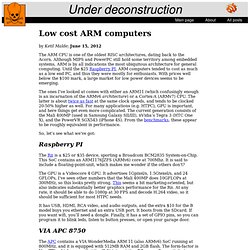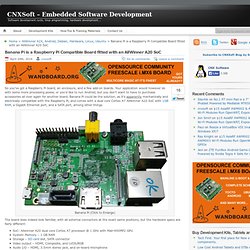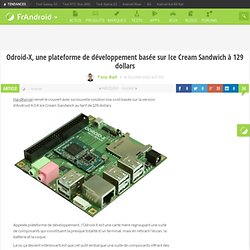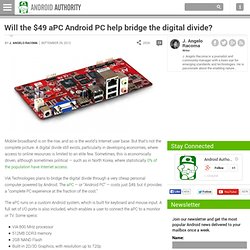

PcDuino. Cubieboard. OLinuXino-Micro ARM9 Linux board available at Mouser. Low cost ARM computers. By Ketil Malde; June 15, 2012 The ARM CPU is one of the oldest RISC architectures, dating back to the Acorn.

Although MIPS and PowerPC still hold some territory among embedded systems, ARM is by all indications the most ubiquitous architecture for general computing. Until the $25 Raspberry PI, ARM computers tended to cost as much as a low end PC, and thus they were mostly for enthusiasts. With prices well below the $100 mark, a large market for low power devices seems to be emerging. The ones I’ve looked at comes with either an ARM11 (which confusingly enough is an incarnation of the ARMv6 architecture) or a Cortex-A (ARMv7) CPU.
UDOO. Banana Pi is a Raspberry Pi Compatible Board fitted with an AllWinner A20 SoC. So you’ve got a Raspberry Pi board, an enclosure, and a few add-on boards.

Your application would however do with some more processing power, or you’d like to run Android, but you don’t want to have to purchase accessories all over again for another board. Banana Pi could be the solution, as it’s apparently mechanically and electrically compatible with the Raspberry Pi, and comes with a dual core Cortex A7 AllWinner A20 SoC with 1GB RAM, a Gigabit Ethernet port, and a SATA port, among other things. Banana Pi (Click to Enlarge) Official Website. Odroid-X, une plateforme de développement basée sur Ice Cream Sandwich à 129 dollars - FrAndroid - Android. Tony Balt • le 13 juillet 2012 à 17:00 13 juillet 2012 HardKernel remet le couvert avec sa nouvelle solution low-cost basée sur la version d’Android 4.0.4 Ice Cream Sandwich au tarif de 129 dollars.

Appelée plateforme de développement, l’Odroid-X est une carte mère regroupant une suite de composants qui constituent la presque totalité d’un terminal, mais en retirant l’écran, la batterie et la coque. En option, il est aussi possible d’y ajouter une caméra, une mémoire eMMC.. même si l’emplacement pour les cartes SD peut aisément la remplacer. Will the $49 Android PC help bridge the digital divide? Mobile broadband is on the rise, and so is the world’s Internet user base.

But that’s not the complete picture. A digital divide still exists, particularly in developing economies, where access to online resources is limited to an elite few. Sometimes, this is economically driven, although sometimes political — such as in North Korea, where statistically 0% of the population have Internet access. VIA Technologies plans to bridge the digital divide through a very cheap personal computer powered by Android.
The aPC — or “Android PC” — costs just $49, but it provides a “complete PC experience at the fraction of the cost.” The aPC runs on a custom Android system, which is built for keyboard and mouse input. Android Mini PC MK802. History and models[edit] MK802: Original design with A10 CPUMK802+: Uses A10s CPU with RAM increased to 1 GB[1]MK802 II: Modified form and slightly increased processor speed[2]MK802 III: A new design featuring a Rockchip RK3066, a dual-core ARM CPU (Cortex-A9 at 1.6 GHz), Mali GPU and 4 GB or 8 GB flash storage that runs Android 4.1.MK802 IIIs: Added Bluetooth support, soft power-off function and XBMC support.MK802 IV: Released in May 2013, a new design featuring a Rockchip RK3188, a quad-core ARM CPU (Cortex-A9 at 1.6 GHz), 2 GB of RAM, 400 MHz Mali GPU and 8 GB of flash storage that runs Android 4.2.[3][4] Connectors[edit] HDMImini or micro USB 2.0USB 2.0microSD slotPower via micro-USB OTG The MK802's success and design has generated a host of similar devices with similar specifications, many of which have similar model numbers, but are not manufactured by Rikomagic.
Also, these devices share many characteristics with the Raspberry Pi computer. See also[edit] External links[edit] Home - Gadgeteer. Objets connectés, avez-vous donc une âme ?- Video et slides de présentation de la session. « Objets connectés, avez-vous donc une âme ?

», Lamartine, égaré dans notre 21ème siècle n'aurait-il pas pu écrire ce vers ? Car après l'explosion des réseaux sociaux qui ont bouleversé les relations entre les hommes, les objets connectés envahissent nos vies. L'IDATE considère qu'en 2020, le nombre d'objets connectés pourrait atteindre 80 milliards dans le monde, soit environ 10 objets par personnes sur la terre. De façon générale, les analystes considèrent l'« Internet des Objets » comme une véritable révolution, de l'« Internet of Things » à l'« Internet of Everything »... En France, le gouvernement y voit un immense gisement de croissance ; les objets connectés font ainsi partie des 34 projets d'avenir, annoncés par le Président Hollande le 12 septembre dernier, visant à relancer l'industrie française. Produits concernés : Windows Windows Server Kinect Xbox SQL Azure Windows Embedded Windows 8.
Tech Days 2014 - Plénière J3 : Objets connectés, avez-vous donc une...